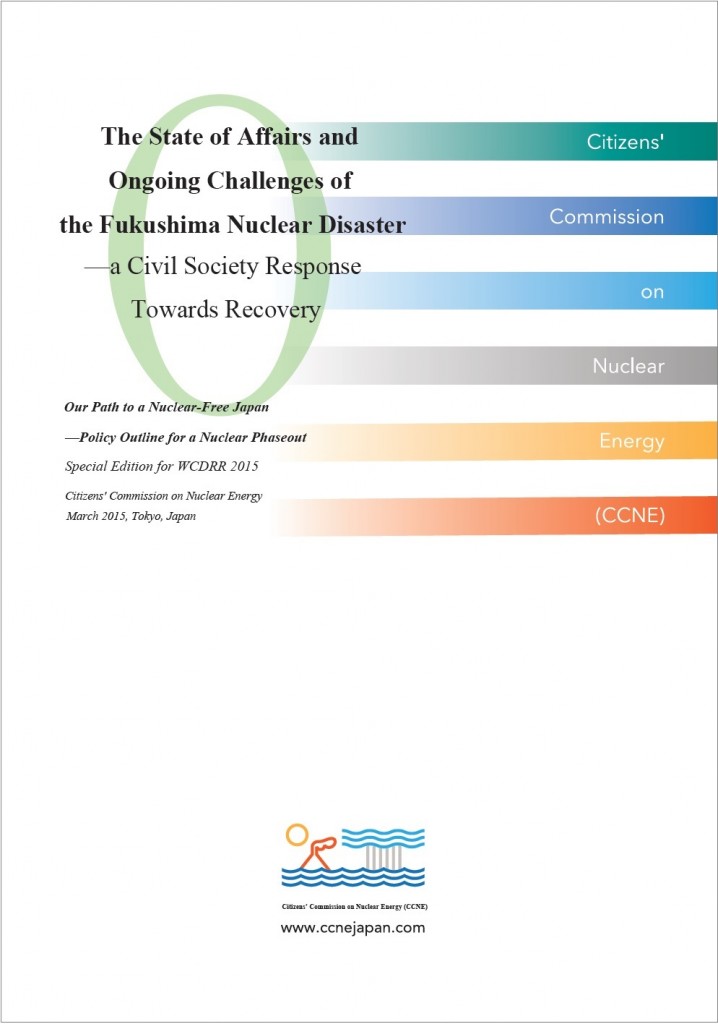Our Path to a Nuclear-Free Japan:
Policy Outline for a Nuclear Phaseout
Our Path to a Nuclear-Free Japan: Policy Outline for a Nuclear Phaseout, originally published in April 2014 in Japanese, is a report prepared with contributions from some 70 professional researchers, scientists, engineers, lawyers and CSO staff, as well as comments obtained through 20 public forums held in various towns in Japan during 2013-2014.
The report covers a wide range of issues, including suffering and damage caused by the nuclear accident, current on-site state of the Fukushima Daiichi, radioactive waste issues, regulation standards, seismological issues and contingency planning, financial considerations and sustainability issues, and the democratic process towards the energy shift.
The disaster is far from over and the victims need care and support. With the translated report, we hope to present correct information to academics, government officials, engineers, technical experts as well as members of civil society and international organisations across the world, and contribute to making progress towards a nuclear-free world.
Executive Summary
List of keywords [Translation in Progress]
List of proposed agencies and legislation [Translation in Progress]
Acknowledgement [Translation in Progress]
Introduction
0-1 Weaknesses in the Financial Management of Nuclear Power Generation
0-2 Problems Caused by the Fukushima Nuclear Power Plant Accident
0-3 Ethical Disqualifications of Nuclear Power
0-4 Nuclear Power Plant Shutdown by Legal Means
0-5 Comprehensive Evaluation of Nuclear Power
0-6 The “3E” Arguments Totally Undermined
0-7 The Four Principles of Social Reasonability
0-8 The Problems of a Tight Power Supply-Demand Balance and Cost Increases
0-9 Policy Reform that Reflects the Will of the People
0-10 Our View on the Nuclear Restart Issue
0-11 Realisation of a Nuclear-Free Society is Not Difficult
1-0 Overview and Structure of Chapter 1
1-1 A Comprehensive View of the Damage and its Particular Characteristics
1-2 The Principles Underpinning the “Restoration of Humanity”
1-3 Principles for Ascertaining and Assessing the Damage
1-4 Countermeasure 1: The Right to Health
1-5 Countermeasure 2: Support for Evacuation and Resettlement
1-6 Countermeasure 3: Decontamination
1-7 Countermeasure 4: Food Safety and the Restoration of Agriculture and Fisheries
1-8 Countermeasure 5: Compensation
Columns
-Destruction of the five layers of the total environment: Structural damage
from the nuclear power plant disaster
-Restoration of Humanity
-Voluntary Measuring Activity Demonstrating Unique Significance and Meaning
-Can attempting to imprint the populace with the notion of ‘safe and secure’
be worthy of the name risk communication?
-Why do measurements on personal dosimeters result in lower values than
measurements on air dosimeters?
-Effective dose, equivalent dose and the one centimetre dose equivalent
-The case of Fukushima City Watari district
-The case of Oguni District in Date City
-Temporary housing living conditions of evacuees from Kawauchi Village
2-0 Overview and Structure of Chapter 2
2-1 The State of Fukushima Daiichi Nuclear Power Station and Unresolved Issues
2-2 Necessity for Clarification of the Causes of the Accident
2-3 Current State of Post-Accident Operations and Organisational Arrangements
Required to Bring the Accident to a Closure
2-4 Air Cooling—A Drastic Solution to the Water Contamination Problem
2-5 How Should the Destroyed Reactors be Finally Disposed Of
2-6 Worker Health Management and Exposure Reduction in the Plant Site
Chapter 3: Treatment and Disposal of Radioactive Wastes [Translation in Progress]
3-0 Overview and Structure of Chapter 3
3-1 Reform of the Nuclear Fuel Reprocessing Policy
3-2 Fast Breed Reactor Policy
3-3 Uranium Enrichment
3-4 Construction of Forums for Catalysing Debate and Reaching Consensus
3-5 The Importance of a New Nuclear Waste Management Organisation
3-6 Policies for Reducing Risk from Spent Nuclear Fuel
3-7 Treatment and Disposal of Plutonium
3-8 Treatment and Disposal of High-Level Radioactive Waste
3-9 Treatment and Disposal of Nuclear Facilities and Low-Level Radioactive Waste
3-10 The Nuclear Fuel Cycle and International Relations
3-11 Nuclear Security Policy
3-12 Nuclear Energy Research
3-13 Recruitment and Training
Chapter 4: Technical Grounds for Keeping Reactors from Restarting [Translation in Progress]
4-0 Overview and Structure of Chapter 4
4-1 Our Views on Safety: The Role and Limits of Regulation
4-2 The Process Behind the Establishment of the New Regulatory Standards and their
Many Structural Defects
4-3 “Non-application of the Guidelines for Reactor Site Assessment” is a Serious
Step Backward
4-4 Nuclear Power Plants Cannot Withstand Earthquakes and Tsunamis
4-5 Severe Accidents Cannot be Prevented Without Design Reviews
4-6 The Results of Compliance Assessment Indicate Serious Problems with Policies for
Dealing with Severe Accidents
4-7 The New Regulatory Standards Fall Far Short of “World-Class”
4-8 Problems Related to Local Governments’ Lack of Authority and Disaster Preparation
in Relation to Nuclear Facility Safety Management
4-9 The Current State of Nuclear Power Regulatory Organisations and Management
Chapter 5: Steps to a Nuclear-Free Society [Translation in Progress]
5-0 Overview and Structure of Chapter 5
5-1 Basic Outline of the Steps to a Nuclear Phaseout
5-2 The Formation of Public Consensus and the Decision-Making Process
5-3 Compensation for Damages, Establishment of a Framework for Cleanup and
the Bankruptcy of TEPCO
5-4 The Need to Review Policies for Nuclear Damage Compensation for Nuclear Facilities
Other than Fukushima Daiichi
5-5 Abolition of Non-TEPCO Owned Nuclear Energy Facilities and the Problem
of Weaning Local Governments Away from Nuclear Energy and
Towards Independence
5-6 Shifting Toward an Energy System for a Sustainable Society
5-7 Nuclear Exports and International Responsibility
Chapter 6: Defects in the Nuclear Power Complex-Led Decision-Making System and the Path to Democratic Policy Decisions
[Translation in Progress]
6-0 Overview and Structure of Chapter 6
6-1 Defects of Nuclear Energy Policy-Making: the Dominance of the “Nuclear Complex”
6-2 What Caused the Divergence Between Public Opinion and Energy Policy-Making?
6-3 What Are the Conditions for Realising Democratic Policy Decision-Making
Epilogue [Translation in Progress]
Spreading Nuclear Phaseout from Japan to the World
Future Tasks
|


